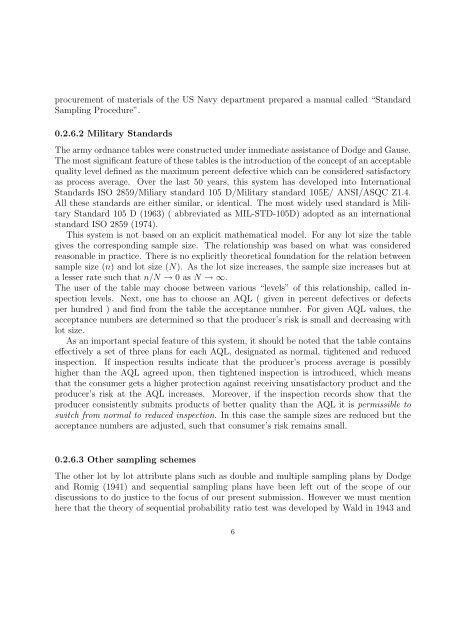Multiattribute acceptance sampling plans - Library(ISI Kolkata ...
Multiattribute acceptance sampling plans - Library(ISI Kolkata ...
Multiattribute acceptance sampling plans - Library(ISI Kolkata ...
Create successful ePaper yourself
Turn your PDF publications into a flip-book with our unique Google optimized e-Paper software.
procurement of materials of the US Navy department prepared a manual called “Standard<br />
Sampling Procedure”.<br />
0.2.6.2 Military Standards<br />
The army ordnance tables were constructed under immediate assistance of Dodge and Gause.<br />
The most significant feature of these tables is the introduction of the concept of an acceptable<br />
quality level defined as the maximum percent defective which can be considered satisfactory<br />
as process average. Over the last 50 years, this system has developed into International<br />
Standards ISO 2859/Miliary standard 105 D/Military standard 105E/ ANSI/ASQC Z1.4.<br />
All these standards are either similar, or identical. The most widely used standard is Military<br />
Standard 105 D (1963) ( abbreviated as MIL-STD-105D) adopted as an international<br />
standard ISO 2859 (1974).<br />
This system is not based on an explicit mathematical model. For any lot size the table<br />
gives the corresponding sample size. The relationship was based on what was considered<br />
reasonable in practice. There is no explicitly theoretical foundation for the relation between<br />
sample size (n) and lot size (N). As the lot size increases, the sample size increases but at<br />
a lesser rate such that n/N → 0 as N → ∞.<br />
The user of the table may choose between various “levels” of this relationship, called inspection<br />
levels. Next, one has to choose an AQL ( given in percent defectives or defects<br />
per hundred ) and find from the table the <strong>acceptance</strong> number. For given AQL values, the<br />
<strong>acceptance</strong> numbers are determined so that the producer’s risk is small and decreasing with<br />
lot size.<br />
As an important special feature of this system, it should be noted that the table contains<br />
effectively a set of three <strong>plans</strong> for each AQL, designated as normal, tightened and reduced<br />
inspection. If inspection results indicate that the producer’s process average is possibly<br />
higher than the AQL agreed upon, then tightened inspection is introduced, which means<br />
that the consumer gets a higher protection against receiving unsatisfactory product and the<br />
producer’s risk at the AQL increases. Moreover, if the inspection records show that the<br />
producer consistently submits products of better quality than the AQL it is permissible to<br />
switch from normal to reduced inspection. In this case the sample sizes are reduced but the<br />
<strong>acceptance</strong> numbers are adjusted, such that consumer’s risk remains small.<br />
0.2.6.3 Other <strong>sampling</strong> schemes<br />
The other lot by lot attribute <strong>plans</strong> such as double and multiple <strong>sampling</strong> <strong>plans</strong> by Dodge<br />
and Romig (1941) and sequential <strong>sampling</strong> <strong>plans</strong> have been left out of the scope of our<br />
discussions to do justice to the focus of our present submission. However we must mention<br />
here that the theory of sequential probability ratio test was developed by Wald in 1943 and<br />
6
















